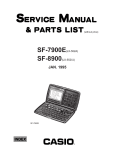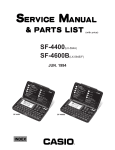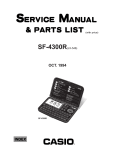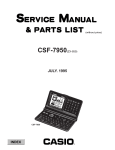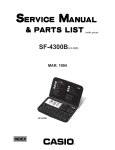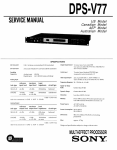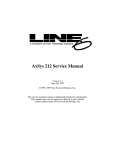Download Casio SF-4600 Specifications
Transcript
(with price) SF-4600RS(ZX-860AT) SF-4900RS(ZX-860ET) JUN. 1995 SF-4600RS SF-4900RS R CONTENTS 1. SCHEMATIC DIAGRAM .................................................................................................... 1 1-1. MAIN PCB .................................................................................................................. 1 1-2. KEY MATRIX ............................................................................................................. 2 2. SPECIFICATIONS ............................................................................................................. 3 3. TO REPLACE THE BATTERIES ....................................................................................... 5 4. DATA TRANSFER ............................................................................................................. 6 5. OPERATION REFERENCE ............................................................................................. 5-1. RESET OPERATION ............................................................................................... 5-2. TO ADJUST THE DISPLAY CONTRAST ............................................................... 5-3. TO CHECK THE MEMORY STATUS ...................................................................... 5-4. THE SOUND MENU ................................................................................................. 6. LSI, IC (Pin function) ...................................................................................................... 12 6-1. CPU .......................................................................................................................... 12 6-2. RAM:CXK58257AM (LSI2,LSI3) ............................................................................. 13 6-3. OPERATION PROGRAM ROM PIN DESCRIPTIONS (µPD23C1001) ................... 13 6-4. RAM PIN DESCRIPTIONS (CXK581000AM) .......................................................... 14 6-5. VOLTAGE REGULATOR:S-81253SGUP (REG1) .................................................. 14 6-6. VOLTAGE DETECTOR:RH5VL46CA (DET1)......................................................... 14 7. TROUBLESHOOTING ..................................................................................................... 15 8. HARD CHECK ................................................................................................................. 18 9. ASSEMBLY VIEW ........................................................................................................... 23 10 10 11 11 11 10. PARTS LIST .................................................................................................................... 25 1. SCHEMATIC DIAGRAMS 1-1. MAIN PCB —1— 1-2. KEY MATRIX —2— 2. SPECIFICATIONS Data storage: Storage and recall of telephone, memo, schedule, reminder data; calendar display; secret area; editing; memory status display. Clock: World time; reminder alarm; schedule alarm; daily alarm; accuracy under normal temperatures: ±3 seconds average. Calculation: 10-digit arithmetic calculations; arithmetic constants (+, –, ×, ÷); independent memory; percentages; square roots; 20-digit approximations; date calculations; other mixed calculations. General: Display element: Memory capacity: 16-column × 4-line LCD SF-4600RS: 64 KB (61282 bytes) SF-4900RS: 128 KB (126818 bytes) LSI 2 lithium batteries (CR2032) 0.05W Main component: Power supply: Power consumption: Battery life: Approximately 350 hours continuous operation in Telephone Directory Approximately 300 hours repeating one minute of input and 10 minutes of display in Telephone Directory Approximately 12 months for memory backup Auto power off: Approximately 6 minutes after last key operation Operating temperature: 0°C ~ 40°C (32°F ~ 104°F) Dimensions: Unfolded: 10.6H × 141W × 159.5Dmm (3/8"H × 5 1/2"W × 6 1/4"D) Folded: 12.4H × 141W × 82Dmm (1/2"H × 5 1/2"W × 3 1/4"D) Weight: 105 g (3.7 oz) Current consumption: Power switch TYP. [µA] MAX [µA] OFF 11 — ON 560 600 Storage Capacity: The 64K(SF-4600RS)/128K(SF-4900RS) bytes memory capacity includes a 61282(SF-4600RS)/ 126818(SF-4900RS) bytes user area. The following shows examples of what this means for the storage of data in each mode. Telephone Directory: Approximately 2918(SF-4600RS)/6038(SF-4900RS), under the following conditions: 8-character name 10-character telephone number —3— Approximately 1459(SF-4600RS)/3019(SF-4900RS), under the following conditions: 8-character name 10-character telephone number 20-character address Memo: Approximately 2785(SF-4600RS)/5764(SF-4900RS), 20-character memos. Schedule Keeper: Approximately 1857(SF-4600RS)/3842(SF-4900RS), under the following conditions: 20 characters per item Starting time specified, alarm time set Approximately 2188(SF-4600RS)/4529(SF-4900RS), under the following conditions: 20 characters per item Starting time specified, no alarm time Reminder: Approximately 3604(SF-4600RS)/7459(SF-4900RS), under the following conditions: 10 characters per item Alarm time set Approximately 4085(SF-4600RS)/8454(SF-4900RS), under the following conditions: 10 characters per item No alarm time —4— 3. TO REPLACE THE BATTERIES 1) Loosen the screw on the back of the unit that holds the battery compartment cover in place, and remove the cover. 2) Loosen the screw that secures one of the two battery holders in place and remove the battery holder. Screw RESET Caution: Be sure to remove only one battery at a time. Otherwise, you will lose all data stored in memory. 3) Replace the old battery with a new one, making sure that the positive (+) side of the new battery is facing up (so you can see it). 4) Replace the battery holder and secure it by tightening its screw. • Be sure careful that you do not over tighten the screw. 5) Repeat steps 2) through 4) for the other two batteries. • Be sure to replace all two batteries. Never mix old batteries with new ones, and be sure to use CR2032 lithium batteries only. 6) After you replace all two batteries, replace the battery compartment cover and secure it by tightening its screw. • Be careful that you do not over tighten the screw. —5— 4. DATA TRANSFER SF-4600RS/4900RS can transfer customers data to other SF-4600RS/4900RS with memory protection only when replacing the LCD or the outer case. * Before connecting the cable (SB-60/62), be sure to reset the slave machine to clear all data. How to transfer the data 1) Turn off the power switch and connect the two units using the cable (SB-60/62) as shown in the drawing. SB-60/62 accessory cable 2) Turn on the power switch of each machine. 3) The slave machine must be set the date of Feb. 3rd, 1901 into the memory under the calculator mode. Operation: 1. Press 2. Select "CAL" mode or press 6. M+ 3. 1 2 M 3 SUN 1901/ 2/ 3 If you don't set the date, the "PASSWORD" isn't transferred to the slave machine. —6— Setting up for Data Communications The following procedures describe what you should do to set up for data communications between two SF Units or between an SF Unit and a personal computer. In addition to hardware connections, it details how to set up the communications parameters and how to set up the SF-Units to receive data. By following these instructions carefully, you can be ensured of successful communications every time. To connect two SF Units 1. 2. 3. Check to make sure that the power of the two SF Units is switched off. Remove the covers from the connectors on the two SF Units. Connect the two SF Units using the optional SB-60/62 cable. You can also connect them using an SB-60/62 cable. Important Be sure to replace the connector covers on the SF Units when you are not performing data communications. 4) Check the hardware parameters. 1. Select "TEL" mode or press 1 under MENU screen. 2. Press twice to display the second function menu. * If the password isn't registered in the SF unit, display shows X instead of "1". • You can perform the above operation while the initial screen of the Memo Mode, Schedule Keeper, Calendar, or Reminder is displayed also. 3. Press 4 to select DATA COMM. 4 4. Press 3 to select SET UP. 3 • N is blinking. —7— If the units have another condition, reset as above. • To change the parameters 3. 5) ∇ Use the and — cursor keys to change the selected parameter on the display. Use the and cursor keys to change the high-lighted setting of the currently selected parameter. Press to store them in memory. ∇ 1. 2. ∇ 5. Set up the slave machine 1. While an initial screen is displayed, press twice to display the second function menu. * If the password isn't registered in the SF unit, display shows X instead of "1". • You can perform the above operation while the initial screen of the Memo Mode, Schedule Keeper, Calendar, or Reminder is displayed also. 2. Press 4 to select DATA COMM. 4 3. Press 2 to select RECEIVE. 2 6) Set up the customer’s machine. 1. While an initial screen is displayed, press twice to display the second function menu. * If the password isn't registered in the SF unit, display shows X instead of "1". • You can perform the above operation while the initial screen of the Memo Mode, Schedule Keeper, Calendar, or Reminder is displayed also. —8— 2. Press 4 to select DATA COMM. 4 3. Press 1 to select SEND. 1 4. Press 3 to select ALL DATA. 3 5. Press to start the send operation or to abort the operation without sending anything. • Data is send in the sequence: Telephone Directory, Memo Mode, Reminder Mode, Schedule Keeper, Calendar. • To abort the send operation at any time, press . • If an error occurs during the send operation, the message “TRANSMIT ERROR!” appears on the display. Press to clear the error message. 6. After the send operation is complete, the display returns to the initial screen of the mode you were in when you started this procedure. —9— 5. OPERATION REFERENCE 5-1. RESET OPERATION The following procedure erases all data stored in the memory of the SF Unit. Perform the following operation only when you want to delete all data and initialize the settings of the SF Unit. Remember-you should always keep copies of important data by writing it down, by transferring it to a personal computer or other SF Unit. To reset the SF Unit's memory 1. Switch on power and press the RESET button with a thin, pointed object. Warning! The next step deletes all data stored in the SF Unit's memory. Make sure that you really want to delete the data before you continue! 2. Press to reset the memory and delete all data or operation without deleting anything. to abort the reset Following the reset operation described above, the Home Time display appears and the SF Unit setting are initialized as noted below. Home Time: Zone: World Time: Alarm Time: Sound: Character input: Language: — 10 — 5-2. TO ADJUST THE DISPLAY CONTRAST ∇ ∇ 1 Enter the Telephone Directory Mode. • You could enter any mode except the Calculator mode here. 2 Press and confirm that the "S" indicator is on the display. 3 Press . 4 Use the and keys to adjust the contrast. 5 After you are finished, press to clear the contrast adjustment display. 5-3. TO CHECK THE MEMORY STATUS Hold down and then hold down to display a screen that shows the current memory status. To clear the memory status display, release . (SF-4900RS) Remaining memory capacity Total number of characters stored in memory 5-4. THE SOUND MENU The sound menu lets you switch the key input tone and the various alarms of the SF Unit on and off. Flashing dot indicates currently selected item Dot indicates on/off status ∇ ∇ — 11 — ∇ The on/off status of each SOUND menu items is indicated by a dot, and the dot that is flashing on the menu is the one that is currently selected. Use and ∇ to change the currently selected (flashing) item. Use and to switch the currently selected item on and off. 6. LSI, IC (Pin function) 6-1. CPU Pin No. 1~5 Signal C0 ~ 4 I/O Out Function Common Signal for display 6 GND In GND /0[V] 7,8 BZ1,2 Out 9 VDD In 10 CSRA1 Out Chip enable signal for RAM (LSI2) 11 CSRA2 Out Chip enable signal for RAM (LSI3 or LSI4) 12 CSROM Out Chip enable signal (Not used) 13 WEB Out Write enable signal for RAM Buzzer terminal Power supply/5.3[V] 14,15 RA15,16 Out Address bus (for LSI4 only) 16 ~ 30 A0 ~ 14 Out Address bus 31 ~ 38 IO0 ~ 7 I/O Data bus 39 ~ 54 KY0 ~ 15 I/O Key signal 55 SW In Battery switch (On: "L"/0[V] 56 DEBUG - Test for manufacturer/5.3[V] 57 ON Out Data communication enable 58 CRCKI In 59 SOUTB Out 60 SIN In Transmission data input 61 VDD In Power supply/5.3[V] 62 TEST - Test for manufacturer 63 VTM - Not used GND/0[V] Transmission data output — 12 — Off: "H"/6[V]) Pin No. 64,65 67,69~71 Signal I/O OSC I/O I/O Function Clock terminal (DT-26S) V1 ~ 4 Voltage for LCD driver OFF: 0[V] ON: V1: 0.64(Light) ~ 1.29(Dark)[V] V2: 1.29 ~ 2.56 [V] V3: 3.99 ~ 2.71 [V] V4: 4.64 ~ 3.99 [V] 68 NC - Not used 72 INTO In Low battery detection 73 STNT - Switch terminal for LCD construction 74 VLCD In Power supply/5.3[V] INTO<5.2[V]=> No power on 75 ~ 171 S0 ~ 95 Out Segment signal for display 172 ~ 199 C5 ~ 32 Out Common signal for display 168,200 NC - Not used VCC WE A13 A8 A9 A11 OE A10 CS IO7 IO6 IO5 IO4 IO3 28 27 26 25 24 23 22 21 20 19 18 17 16 15 CPU (WEB) A13 A8 A9 A11 A10 CPU (CSRA1 or 2) IO7 IO6 IO5 IO4 IO3 DATA BUS 11 12 13 A14 A12 A7 A6 A5 A4 A3 A2 A1 A0 IO0 IO1 IO2 GND ADDRESS BUS 1 2 3 4 5 6 7 8 9 10 CXK58257AM IO0 IO1 IO2 A14 A12 A7 A6 A5 A4 A3 A2 A1 A0 A0 ~ A14 : IO0 ~ IO7 : WE : CS : OE : Address input signal Data signal (Input/Output) Write enable signal Chip select signal Output enable signal VSS DATA BUS ADDRESS BUS 0.1µ 6-2. RAM: CXK58257AM (LSI2, LSI3) 6-3. OPERATION PROGRAM ROM PIN DESCRIPTIONS (µPD23C1001) Pin No. Name In/Out Status of OFF Status of ON Description 2~12,23, 25~31 13~15, 17~21 16 22 24 1, 32 A0~A18 In L Pulse Address bus line (A0~A14, RA15~RA18) O0~O7 GND CE OE VPP, VCC Out In In In In L L H L L Pulse L Pulse Pulse H Data bus line (IO0~IO7) GND terminal Chip enable signal from CPU (CS ROM) Output enable signal / GND VDD terminal — 13 — 6-4. RAM PIN DESCRIPTIONS (CXK581000AM) Pin No. Name In/Out Status of OFF Status of ON Description 2~12,23, 25~28, 31 13~15, 17~21 16 22 24 1, 32 29 A0~A16 In L Pulse Address bus line (A0~A14, RA15, RA16) O0~O7 GND CS1 OEB N.C., VCC WE Out In In In In In L L H L L H Pulse L Pulse Pulse H Pulse Data bus line (IO0~IO7) GND terminal Chip enable signal from CPU (CSRA2) Output enable signal / GND VDD terminal Write enable signal from CPU (WEB) 6-5. VOLTAGE REGULATOR: S-81253SGUP (REG1) Output Voltage (Vout) : 5.3V ± 5% VIN 2 3 OUT RA + – RI RB VREF 1 2 3 GND Vin Vout GND 1 6-6. VOLTAGE DETECTOR: RH5VL46CA (DET1) Detection Voltage(–VDET) : 5.2V ± 2.5% [5.07V (MIN) ~ 5.33V (MAX)] 2 VDD 1 OUT 1 2 3 Vout Vin GND 3 VSS VDD +VDET –VDET VDD VDD VSS — 14 — Input voltage Output voltage >5.2V 5V <5.2V 0V 7. TROUBLESHOOTING < No power on > N Adjust contrast Is contrast adjustment OK? Y N Replace batteries Is power of batteries enough? Y Y Does display appear by pressing Reset button? Check other function N Y Does it sound by key enter? Refer to <No/Erratic display> N Do batteries make positive contact with the battery springs? N Adjust contact and clean battery spring Y Y Is 3-pin of S-81253 (REG1) 5.3 [V]? N N Are capacitor C8 ~ C16 OK? Replace the spoiled capacitor Y Replace REG1 1 — 15 — 1 N Replace DET1 Is 1-Pin of RH5VL46CA (DET 1) 5[V]? Y N Are 10, 11, and 13-Pins of CPU (LSI 1) sending the signals? Replace CPU (LSI1) Y N Does RAM make positive contact with PCB? Resolder RAM (LSI2, LSI3 or LSI4) Y N Is 12-Pin of CPU (LSI1) sending the signal? Replace CPU (LSI1) Y N Does ROM make positive contact with PCB? Resolder ROM (LSI5) Y Replace RAM (LSI2, LSI3 or LSI4) or CPU (LSI1) < No key input > Does key make positive contact with PCB Ass’y N Replace PCB Y Does CPU make positive contact with PCB? Y Replace CPU (LSI1) — 16 — N Resolder CPU (LSI1) < No/Erratic display > N Is input 2-Pin of S-81253 (REG1) 6[V]? Check batteries Y N Is output 3-Pin of S-81253 (REG1) 5.3[V]? Replace REG1 Y *Are voltage of several capacitors enough? V1: V2: V3: V4: N 1.3 [V] 2.5 [V] 2.7 [V] 3.9 [V] Y Check solder part of C1, C2, C3, C4, C7 or replace. *CONTRAST: MAX N Does CPU (LSI1) make positive contact with PCB? Resolder Y Replace CPU (LSI1) < High current consumption > Y Is there any short circuit? Check PCB N N Replace capacitors Are the several capacitors OK? Y Resolder/Replace CPU, IC — 17 — 8. HARD CHECK No. OPERATION DISPLAY 1 Turn on while short the short pad (KEY69). SELF TEST PROG. PRESS SEARCH QUIT BY OFF CASIO APR. 1994 TEST MENU 3 Main menu 1 DISP MEMORY KEY BUZZER I/F DISP 1 WHITE 2 BLACK 3 CHECK. 4 5 6 7 RVS. FRAME DOT 4 TIME Display check 1 4 No display 2 5 All dots display 3 6 Checker display 4 7 The short pad is located behind the tape I. 2 3 4 5 2 1 NOTE Reverse checker display — 18 — No. OPERATION DISPLAY NOTE 5 8 FRAME 6 9 Dots appear at 4 corners. TIME DISPLAY 10 7 Check if timer is working. 00:00:00 TEST MENU 2 3 4 5 11 1 DISP 12 3 13 2 KEY MEMORY KEY BUZZER EXT 1 RANDOM 2 AUTO Key check No display 00 01 02 ............... 14 — 19 — 03 56 04 57 ............... • Check the key No. appears on the display. • Check the key sounds. • To return to the menu mode, enter . No. OPERATION DISPLAY TEST MENU 15 2 3 4 5 1 DISP 4 BUZZER MEMORY KEY BUZZER EXT 1 BEEP 2 ALARM1 3 ALARM2 16 NOTE Buzzer check 2 EXECUTING!! 17 BUZZER 1 BEEP 2 ALARM1 3 ALARM2 TEST MENU 2 3 4 5 MEMORY KEY BUZZER EXT 3 4 5 6 WR2 READ2 DUMP CHKSUM 18 19 1 DISP 2 MEMORY 1 WR1 2 READ1 20 1 21 WRITE1 — 20 — Check the alarm 1 sound. RAM check No. OPERATION (After few seconds) 22 DISPLAY MEMORY 1 WR1 2 READ1 2 3 4 5 6 NOTE WR2 READ2 DUMP CHKSUM EXECUTING 23 COMPLETE 64KB (128KB) 24 MEMORY 25 1 WR1 2 READ1 6 FE C3 26 TY 0 A TEST MENU 27 1 DISP 28 Press "RESET" key. — 21 — 3 4 5 6 WR2 READ2 DUMP CHKSUM SZ SUM XOR 128 18EX XX XX XXX XX 2 3 4 6 MEMORY KEY BUZZER EXT Check sound. If RAM has defect, error message will be appered. ROM check 9. ASSEMBLY VIEW 14 26 27 19 15 18 34 23 — 23 — 5 2 1 4 20 LSI 16 3 6 8 11 9 24 10 7 17 12 13 25 21 22 10. N Item N N 5 5 N N N N N N N N N N N N N N N N A: SF-4600RS B: SF-4900RS FOB Japan Q'ty M N.R.Yen R A B Unit Price PARTS LIST Code No. Specification PCB ASS'Y 6414 9840 PCB ass'y DB25XX0300N 6414 9850 PCB ass'y DB25AX0300T (The two assemblies contain the following available elements.) C1~4,7,8, 10,14~16 C12 C5,6 C9,11 D1 D2 DET1 EF1 JC1 LSI1 LSI2,3 LSI4 LSI5 Q1 R3,14 R5 R6 R7 R8,9 R11 REG1 X1 1 2 3 4 34 6 7 7 8 9 10 11 12 12 13 14 14 15 16 17 17 18 Notes: Parts Name N M R Q 2845 1540 Chip capacitor MCH212F104ZK 2845 1540 Chip capacitor 2845 2534 Chip capacitor 2803 6806 Electrolytic capacitor 2390 2128 Chip diode 2390 0364 Schottky diode 2105 3864 CMOS IC 3013 2002 Chip inductor 3501 6538 Jack 6412 3981 L594 TAB sub ass'y 2011 8071 LSI (RAM) 2011 9422 LSI (RAM) 2012 0693 LSI (ROM) 2259 0959 Chip digital transistor 2797 3752 Chip resistor 2791 1170 Chip resistor 2797 0637 Chip resistor 2797 1309 Chip resistor 2797 1078 Chip resistor 6512 1420 Chip resistor 2105 3290 Regulator 7110 0642 Crystal oscillator 3335 5628 LCD 6409 6270 Heat seal 6410 9810 Battery plate (+) 6409 6310 Battery plate (-) 6406 8940 Adhesive tape COMPONENTS 3122 2380 Buzzer 6414 9770 Lower cabinet 6414 9780 Lower cabinet 6510 4440 Nut tape 6510 4500 Buzzew tape 6512 1080 Nut 6408 5920 Switch knob ass'y 6411 6080 Battery cover 6411 2580 Battery cover 6409 6120 Battery holder 6414 9880 PC sheet 6414 9890 PC sheet 6410 9670 Push button 6414 9900 Overlay mylar 6411 6030 Mask tape 6410 9680 Mask tape 6414 9910 Rubber key sheet – New parts – Minimum order/supply quantity – Rank – Quantity used per unit MCH212F104ZK MCH185A180JK 10MS510M-MW MA740-(TX) MA713-TX RH5VL46CA BLM21A10PT HSJ1169-012010 C312133A*4 CXK58257AM-10/12L CXK581000AM-10LL UPD23C1001EAGW-N07 DTC114YKT-146 ERJ-6GEYJ000 ERJ-6GEYJ182 ERJ-6GEYJ473 ERJ-6GEYJ102 ERJ-6GEYJ101 CC0015D11T0 S-81253SGUP-DIJ-T1 DT-26S CD429-TS FX200P40056 EF01DB10107 EF02DB10100 XX063810006 1 0 EFB-S55C41A8 FABDB100003 FABDB100011 HGFC0001206 HGFC0000501 MD100000602 DB2AXX4A00M*1 FADDB100018 FADDB100000 ECDB1011108 EL5C0011609 EL5C0011706 FB3DB100001 EL4K0004105 HGC00001501 HGC00001609 LADB2510003 R–A: B: C: X: — 25 — 1 1 2,990 3,330 A A 10 10 20 4 C 4 4 13 50 33 45 14 56 960 530 1,220 310 12 3 3 2 3 3 3 60 57 350 82 14 16 100 C C C C C B B C A B B B B C C C C C C B B A A C C C 1 2 2 1 1 1 1 1 1 2 0 1 1 1 1 1 1 2 1 1 1 1 1 2 2 2 0 1 0 2 2 1 1 1 1 1 1 0 1 1 1 1 1 1 1 2 1 1 1 1 1 2 2 2 20 20 20 20 20 10 20 5 1 1 1 1 20 20 20 20 20 20 20 5 1 1 5 20 20 1 36 1 1 10 63 1 0 5 63 0 1 5 6 3 3 20 17 1 1 20 13 3 3 20 30 1 1 20 29 1 0 20 29 0 1 20 26 2 2 20 63 1 0 5 63 0 1 5 130 1 1 1 26 1 1 20 9 1 0 20 9 0 1 20 170 1 0 1 Essential Stock recommended Others No stock recommended C X X X X X C X X X C C X X X X C N Item Code No. N N N 18 19 19 20 21 22 23 24 25 26 26 27 27 6414 9920 6414 9930 6414 9940 6510 4290 6510 4310 6510 4350 6511 7160 6511 8400 6512 0980 6414 9950 6414 9960 6414 9970 6414 9980 N N N N Notes: N M R Q – – – – Parts Name Rubber key sheet Upper cabinet Upper cabinet Screw Screw Screw RB insert Key contact rubber Screw Hard case Hard case Label Label Specification Q'ty A B 0 1 1 0 0 1 1 1 2 2 1 1 1 1 1 1 8 8 1 0 0 1 1 0 0 1 LADB2510101 FAADB251005 FAADB251013 MAB80002303 MAA80006311 MAA80006302 LC120000102 LADB0220105 MAB20086306 FC1DB101029 FC1DB101045 HGP00000208 HGP00000607 New parts Minimum order/supply quantity Rank Quantity used per unit R–A: B: C: X: — 26 — M 1 1 1 20 20 20 20 20 20 5 5 1 1 FOB Japan N.R.Yen Unit Price 230 140 140 3 3 2 17 10 2 84 84 110 110 Essential Stock recommended Others No stock recommended R C X X X C B B C X X X X X MA0800151A



























